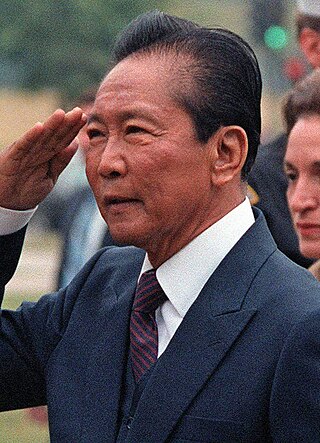
Ferdinand Emmanuel Edralin Marcos Sr. was a Filipino politician, lawyer, dictator, and kleptocrat who was the 10th president of the Philippines from 1965 to 1986. He ruled under martial law from 1972 until 1981 and kept most of his martial law powers until he was deposed in 1986, branding his rule as "constitutional authoritarianism" under his Kilusang Bagong Lipunan. One of the most controversial leaders of the 20th century, Marcos's rule was infamous for its corruption, extravagance, and brutality.
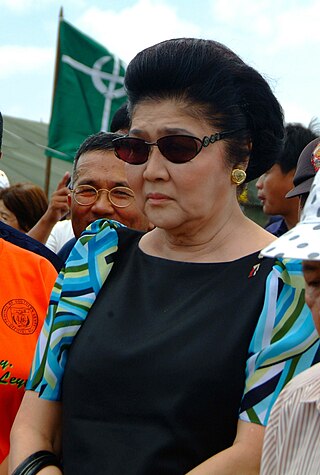
Imelda Romualdez Marcos is a Filipino politician who served as the First Lady of the Philippines from 1965 to 1986, wielding significant political power during the Presidency of her husband, 10th president Ferdinand Marcos. She is the mother of current president Bongbong Marcos.
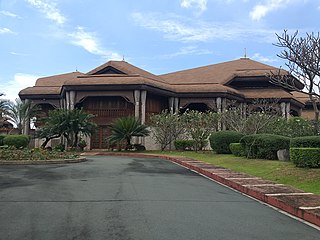
Coconut Palace, also known as Tahanang Pilipino, is a government building located in the Cultural Center of the Philippines Complex in Manila, Philippines. It was the official residence and the principal workplace of the vice president of the Philippines during the term of Jejomar Binay.

The San Juanico Bridge is part of the Pan-Philippine Highway and stretches from Samar to Leyte across the San Juanico Strait in the Philippines. Its longest length is a steel girder viaduct built on reinforced concrete piers, and its main span is of an arch-shaped truss design. Constructed during the administration of President Ferdinand Marcos through Japanese Official Development Assistance loans, it has a total length of 2.16 kilometers (1.34 mi)—the second longest bridge spanning a body of seawater in the Philippines after Cebu-Cordova Bridge.

Filipino nationalism refers to the establishment and support of a political identity associated with the modern nation-state of the Philippines, leading to a wide-ranging campaign for political, social, and economic freedom in the Philippines. This gradually emerged from various political and armed movements throughout most of the Spanish East Indies—but which has long been fragmented and inconsistent with contemporary definitions of such nationalism—as a consequence of more than three centuries of Spanish rule. These movements are characterized by the upsurge of anti-colonialist sentiments and ideals which peaked in the late 19th century led mostly by the ilustrado or landed, educated elites, whether peninsulares, insulares, or native (Indio). This served as the backbone of the first nationalist revolution in Asia, the Philippine Revolution of 1896. The modern concept would later be fully actualized upon the inception of a Philippine state with its contemporary borders after being granted independence by the United States by the 1946 Treaty of Manila.

The Philippine Heart Center is a hospital in Central, Quezon City, Philippines, specializing in the treatment of heart ailments. It was established in 1975.

The Cultural Center of the Philippines is a government-owned and controlled corporation established to preserve, develop and promote arts and culture in the Philippines. The CCP was established through Executive Order No. 30 s. 1966 by President Ferdinand Marcos. Although an independent institution of the Philippine government, it receives an annual subsidy and is placed under the National Commission for Culture and the Arts for purposes of policy coordination. The CCP is headed by an 11-member Board of Trustees, currently headed by Chairperson Margarita Moran-Floirendo. Its current president is Arsenio Lizaso.

The Philippine International Convention Center is a convention center located in the Cultural Center of the Philippines Complex in Pasay, Metro Manila, Philippines. The facility has been the host of numerous local and foreign conventions, meetings, fairs, and social events.
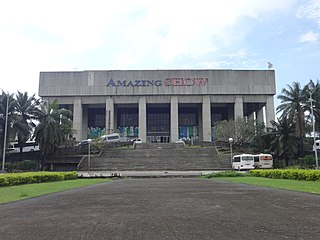
The Manila Film Center is a national building located at the southwest end of the Cultural Center of the Philippines Complex in Pasay, Philippines. The structure was designed by architect Froilan Hong where its edifice is supported on more than nine hundred piles which reaches to the bed-rock about 120 feet below.

The history of the Philippines, from 1965 to 1986, covers the presidency of Ferdinand Marcos. The Marcos era includes the final years of the Third Republic (1965–1972), the Philippines under martial law (1972–1981), and the majority of the Fourth Republic (1981–1986). By the end of the Marcos dictatorial era, the country was experiencing a debt crisis, extreme poverty, and severe underemployment.
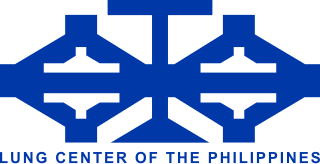
The Lung Center of the Philippines (LCP) is a government tertiary hospital specializing in the cure and prevention of lung and other chest diseases, located on Central, Quezon City, Philippines. The center receives budgetary support for its operations from the national government. It was constructed on public land donated by the National Housing Authority.

The Fourth Philippine Republic, also known as the FourthRepublic of the Philippines was established after Ferdinand Marcos Sr won the June 16, 1981, Philippine Presidential Election. Marcos announced the beginning of the Fourth Republic on June 30, during his inauguration speech. On February 25, 1986, due to the 1986 EDSA Revolution, Marcos ended into exile in Hawaii and Corazon Aquino became the 11th president of the Philippines. The Fourth Republic would come to an end under Aquino's leadership, and the Fifth Republic would commence with the adoption of a new constitution.

The Philippine Center is an agency of the Philippine Government in New York City and San Francisco in the United States. The New York City structure houses the Philippine Mission to the United Nations, the Philippine Consulate General, and the overseas offices of the Department of Trade and Industry and the Department of Tourism. The Philippine Center Management (PCMB) manages the building and its properties. It is committed to "nurture, promote, and propagate Philippine culture, encourage foreign tourists to visit the Philippines, expand foreign markets of Philippine products, and enhance the image of the Philippines."

The Cultural Center of the Philippines Complex, also known as the CCP Complex, is an 88-hectare (220-acre) reclaimed property owned by the Cultural Center of the Philippines (CCP) located along Roxas Boulevard in Metro Manila, Philippines. It is a mixed-use cultural and tourism hub overlooking Manila Bay in south-central Manila, most of which fall under the jurisdiction of the city of Pasay.
The term "edifice complex" was coined in the 1970s to describe Philippine First Lady Imelda Marcos' practice of using publicly funded construction projects as political and election propaganda.
Rodolfo Cuenca, sometimes known by his nickname, Rudy Cuenca, is a Filipino businessman best known as the former chairman of the Construction and Development Corporation of the Philippines (CDCP), which is known today as the Philippine National Construction Corporation. He was a close associate of Ferdinand Marcos, and is noted not to be embarrassed by "his much-criticized close association with Marcos and his being tagged as a crony."
Certain associates of former Philippine President Ferdinand Marcos, historically referred to using the catchphrase "Marcos cronies", benefited from their friendship with Marcos – whether in terms of legal assistance, political favors, or facilitation of business monopolies, during his administration. Marcos critics, and the local and international press began referring to these individuals as "cronies" during the latter days of the Marcos dictatorship, and the Philippine government – especially the Presidential Commission on Good Government (PCGG) – continued using the term after the ouster of Marcos in 1986.

Ferdinand Marcos was inaugurated to his first term as the 10th president of the Philippines on December 30, 1965. His inauguration marked the beginning of his two-decade long stay in power, even though the 1935 Philippine Constitution had set a limit of only two four-year terms of office. Marcos had won the Philippine presidential election of 1965 against the incumbent president, Diosdado Macapagal.
Ferdinand Marcos developed a cult of personality as a way of remaining President of the Philippines for 20 years, in a way that political scientists have compared to other authoritarian and totalitarian leaders such as Joseph Stalin and Adolf Hitler, but also to more contemporary dictators such as Suharto in Indonesia, Saddam Hussein in Iraq, and the Kim dynasty of North Korea.

The Marcos family, a political family in the Philippines, owns various assets that Philippine courts have determined to have been acquired through illicit means during the presidency of Ferdinand Marcos from 1965–1986. These assets are referred to using several terms, including "ill-gotten wealth" and "unexplained wealth," while some authors such as Belinda Aquino and Philippine Senator Jovito Salonga more bluntly refer to it as the "Marcos Plunder".













